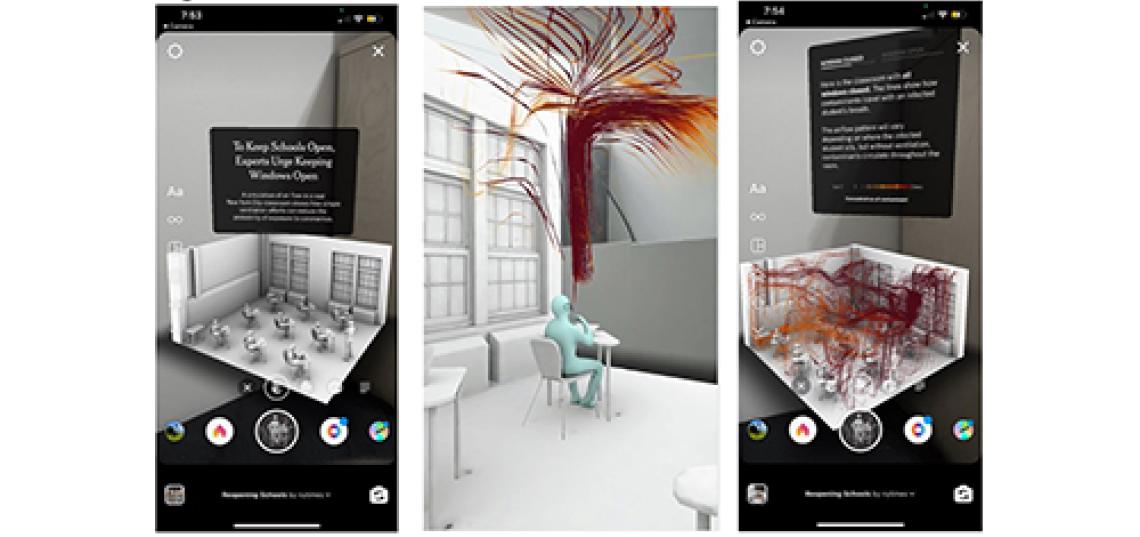
Journalists who utilize Experiential Media (EM) (communication platforms or technical interfaces such as augmented reality (AR), virtual reality (VR), and 360° video) in their reporting on the COVID-19 pandemic communicate the pandemic’s dangers more effectively, according to new research by SC&I Ph.D. Candidate Shravan Regret Iyer.
“My findings,” Iyer said, “suggest that reporters who utilize EM more clearly portray COVID-19’s health risks, the inner workings of how the virus spreads, and precautions required to prevent its spread (such as the use ofN95 masks) than text-based reporting through the use of 3-dimensional visualization, first-person narrative, varied camera angles, and narration.”
Iyer presented his findings at the 20th Annual International Conference on Communication and Mass Media held on May 9-12th, 2022, in Athens, Greece, (and virtually). His paper, “Understanding How News Content Utilizes Experiential Media (AR, VR, and 360° video) in COVID-19 Storytelling,” was published in April 2023 in the Athens Journal of Mass Media and Communications.
"EM tools offer multisensory and immersive qualities that enable users to make practical contact or experience the phenomena virtually.”
Iyer, whose research interest focuses on understanding EM uses in science communication for social change, said, “The existing body of scholarly work in social sciences, particularly media studies, suggests that such EM tools offer multisensory and immersive qualities that enable users to make practical contact or experience the phenomena virtually.”
To conduct the study, Iyer said he used SC&I Professor of Media Studies John Pavlik’s Experiential Media theoretical framework to examine EM pandemic news coverage by the New York Times, the National Geographic, and Meta’s Oculus. He chose these three media outlets “because they are active producers of EM content production on various journalism beats, including health.”
To examine their EM productions, Iyer’s research tools included an iPhone 12 Pro Max with a LiDAR sensor for AR and an Oculus Quest 2 for VR and 360-video.
As an example of the effective use of EM in pandemic reporting, Iyer pointed to a story in The New York Times that utilized 3D visualization and the AR experience to highlight the importance of ventilation in a classroom during the COVID-19 pandemic.
“The AR experience,” Iyer said “which requires a smartphone with LiDAR sensory to trigger the AR content through Meta’s Instagram app, allows the user to step inside a classroom to understand how the coronavirus/contaminants spread indoors, where the user can switch back and forth between different stages or scenarios during the immersive experience journey, including simulations of airflow in a real New York City classroom, showing how simple ventilation efforts can reduce the probability of coronavirus exposure, compared to a scenario where the classroom windows are closed and how the contaminants travel with an infected student’s breath.
“The 3D illustration of the airflow pattern shows how the airflow pattern varies depending on where the infected student sits and how when the windows of the classroom are kept open, the fresh flow of air helps in the drastic drop in overall contamination. Such 3D visualization has the potential to create more awareness of the inner workings of COVID-19, particularly how it spreads and how it can be reduced effectively. Further, such 3D visualization through AR offered new knowledge in terms of the quality of ventilation, the importance of building engineering, the importance of wearing masks, social distancing (six feet distance), and virus transmission indoors.”
“Media organizations could continue to use EM to create awareness of COVID-19 or any future health crisis to prevent the spread of the virus and help mitigate the start of a new outbreak/pandemic.”
Iyer said that while the World Health Organization (WHO) has recently announced that “the COVID-19 virus no longer constitutes a public health emergency of international concern, media organizations worldwide continue to work alongside the health and social science professionals to highlight the impacts of new versions of the coronavirus including the latest virus, BA.2.86, nicknamed Pirola, which has led to an increase in the COVID-19 hospitalizations again in fall 2023.”
“Considering such an increase in cases and newer variants of the virus,” Iyer said, “media organizations could continue to use EM to create awareness of COVID-19 or any future health crisis to prevent the spread of the virus and help mitigate the start of a new outbreak/pandemic.”
Learn more about the Ph.D. Program at the Rutgers School of Communication and Information on the website.
Photo: Screenshots of an AR experience from Shravan Regret Iyer's iPhone 12 Pro Max. Courtesy of Shravan Regret Iyer.
